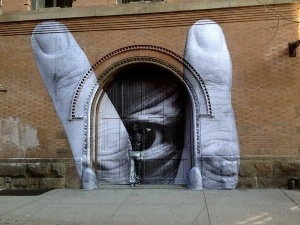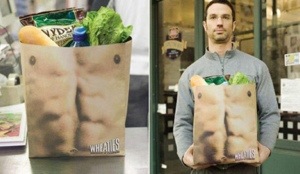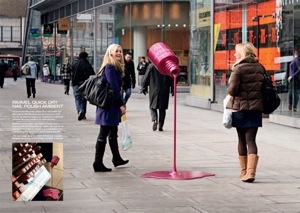David Carson Design
Dagnie Johnson
Survey of Design
Tony Dattilo
To begin with, a bit of an explanation. David Carson is the graphic designer and typography artist that basically invented the grunge style that is so constantly imitated today. A Texan born in the 1950s, he is known as the man who, as often put, “broke the rules of graphic design” to step out of the norm and create an ultimately new and unheard of style – grunge typography. He experimented with distorted and fragmented typefaces that ended up being practically illegible and altogether difficult to read. Though, they i n themselves were art. The degree to which these typographic pieces were done were so extreme and unheard of that they instantly caught the eye of the world, which is why he is known to have “changed the public face of graphic design”.
n themselves were art. The degree to which these typographic pieces were done were so extreme and unheard of that they instantly caught the eye of the world, which is why he is known to have “changed the public face of graphic design”.
Known as the “King of Grunge” these days, David Carson never actually got into graphic design until he went to a two week graphic design course that was being held at the University of Arizona back in 1983. This was followed by a second graphic design course three years later that was being held somewhere in Switzerland – this one, three weeks long. He was originally a sociology teacher and professional surfer. By chance, he had an absolute knack for graphic design that was completely unheard of. It was in the early 1990s when he worked as an art director for Ray gun, a music magazine, that he truly started receiving recognition. It was at one point that he even, in a successful attempt at going completely and utterly against the journalistic norm, printed an entire interview with Bryan Ferry in the Dingbat font. Luckily for Bryan Ferry and readers, the article was also printed in a legible font in the back of the magazine.
Being a major fan of the entire grunge style in graphic design, the first thing I noticed about David Carson’s work was definitely that it could not be read unless I were to at some point tilt my head to read the rest of whatever the word is. Meanwhile, his graphic pieces always have differently sized text or letters forming all kinds of gibberish scattered all over and set on top of the images, which have some kind of gruff texture on it. The pictures he uses in them usually look extremely old or worn down. At times, he would even use a slightly blurred photo, as if the photographer didn’t bother to focus his lens before taking the photo.
All of David’s pieces are very pieced together and, since every piece has some kind of difficult-to-read scrawling on it, leave you having to focus to read whatever it says. Besides being completely innovative, this is a rather ingenious design. After all, if someone has to stop and focus on something, then that means that they are spending that much more time examining whatever he made. They don’t just glance at it and say “oh, that’s nice,” and walk away. People actually stop and realize  “Woah, wait, this actually says something, doesn’t it?” the moment they notice the first word. Then, their curiosity kicks in and they want to know what the entire thing says, leading them to stare at the image for quite some time until they have figured it out. They end up doing this to his logos, as well, since they are even more illegible than his general graphic print works and advertisements. People examine these pieces for long enough that they then will remember this style and/or logo, especially after how long they spent trying to decipher it.
“Woah, wait, this actually says something, doesn’t it?” the moment they notice the first word. Then, their curiosity kicks in and they want to know what the entire thing says, leading them to stare at the image for quite some time until they have figured it out. They end up doing this to his logos, as well, since they are even more illegible than his general graphic print works and advertisements. People examine these pieces for long enough that they then will remember this style and/or logo, especially after how long they spent trying to decipher it.
Because of his strange and urban style, David Carson has been hired to do work for big name places and clients, such as Kodak, Fox Television, Warner Brothers, Quiksilver, AT&T, Pepsi Cola, Nike, Levi, Toyota, Nine Inch Nails, MTV, and many more. For many of these places, he has been doing work for them since 1995, where his style was still rather unnatural. This is unlike today, where we see styles that imitate Carson’s in our everyday lives, whether we realize it or not.
In his work with Pepsi Cola, David Carson was the man who started the series of ads that showed a long paragraph of text in the shape of a Pepsi can or bottle with the red strips and about one half or a third of the logo across it. This is similar to the Coca Cola ad campaign that featured a silhouette bottle with random words describing the feelings people get when they drink the soda plastered across the silhouette and making it up. The way it differs, however, is in the Pepsi advertisements, the text actually made up an entire paragraph saying all kinds of things that relate to every part of the demographic in some way.
One that was featured around athletes and was shaped like a 2-liter bottle would say sentences starting with “I wanna,” such as “I wanna bend the rim,” “I wanna stop a slap shot,” “I wanna steal home,” etc. Another was featured around general hobbies and teen thoughts, making it rather random. It featured the same basic thing – random sentences starting with “I wanna.” This one was shape d like a classic soda bottle and featured sayings such as “I wanna tune in,” “I wanna drip dry,” “I wanna enter the 4th dimension,” “I wanna have 500 watts per channel,” and much, much more.
d like a classic soda bottle and featured sayings such as “I wanna tune in,” “I wanna drip dry,” “I wanna enter the 4th dimension,” “I wanna have 500 watts per channel,” and much, much more.
All of these ads, though, had three lines that were exactly the same and were basically supposed to be the reason why you drink Pepsi above all of them, and those were “I wanna be young,” “I wanna have fun,” “I wanna drink Pepsi.” These ads David Carson created for Pepsi Cola were supposed to make it feel like people who are like us and who we can relate to drink Pepsi, then instill in our mind that if we drink Pepsi, too, then we will be a part of something. After all, we “wanna be young” and “wanna have fun.”
It was projects like these that show the true genius of the man and how, in all sorts of different forms, he is able to crawl into our brain and get us to stop and focus on his art in some way, shape, or form. Whether it is because we need to move our heads to even read what something is supposed to say, whether something just plain ‘looks cool’, or whether it’s putting a paragraph on something that we then feel the need to read, David Carson definitely knows how to get views and he makes marvelous pieces in the process. It is because of this absolute genius that he differs from other designers and why he is a graphic legend in the grunge world.
The piece I created imitating his style was inspired by this style and piece;

Mine:













